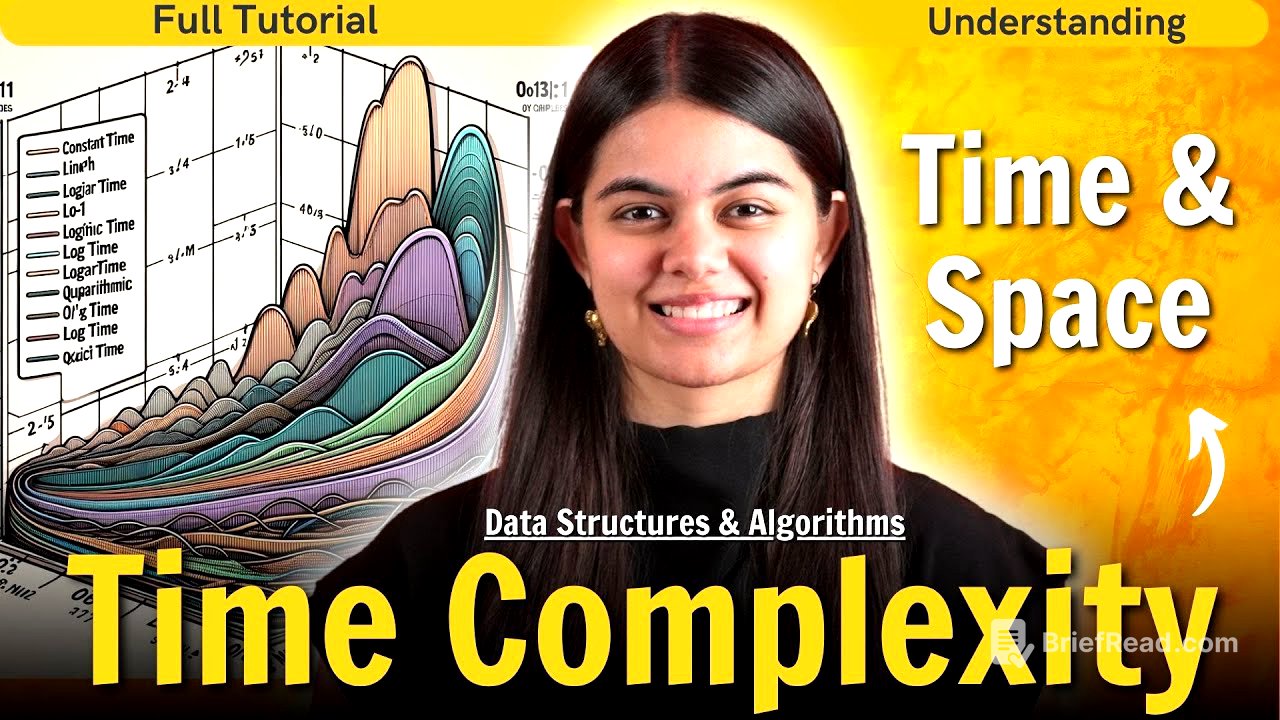TLDR;
This video provides a comprehensive guide to understanding time and space complexity in computer science, crucial for efficient algorithm design and problem-solving. It covers key concepts such as Big O notation, common time complexities, and practical applications in coding interviews and competitive programming. The video also addresses space complexity, recursion, and provides practical tips for optimizing code performance based on problem constraints.
- Time complexity measures the time taken by an algorithm as a function of input size, focusing on the number of operations performed.
- Big O notation is used to express the upper bound of an algorithm's time complexity, representing the worst-case scenario.
- Space complexity refers to the amount of memory space required by an algorithm, including input space and auxiliary space.
Introduction [0:00]
The video introduces a comprehensive series on Data Structures and Algorithms (DSA), emphasizing time complexity as a fundamental concept. The series aims to provide in-depth knowledge relevant for placements and interviews, with additional resources available on the channel.
Disclaimer [0:23]
The lecture covers time and space complexity, including sorting algorithms and recursion. Students familiar with sorting and recursion can watch the entire lecture, while beginners can focus on time complexity without getting overwhelmed by advanced algorithms. The practical usage section is essential for all viewers.
Why study these concepts? [1:17]
Time and space complexity are crucial in programming because they are fundamental to algorithm and data structure selection. These concepts are essential for solving coding problems on various platforms and are frequently assessed in interviews to determine the efficiency of solutions. Understanding time and space complexity helps in developing efficient solutions and is relevant to almost every programming concept.
Time Complexity [2:23]
Time complexity measures the amount of time taken by code to run as a function of the input size, measured in terms of operations. It is not the actual execution time, which can vary based on the machine. Instead, it focuses on how the number of operations changes with the input size. For example, in linear search, the number of operations increases linearly with the size of the array.
Big O Notation [10:53]
Big O notation is a symbolic representation of time complexity, indicating the upper bound or worst-case scenario of an algorithm's performance. It helps in comparing the efficiency of different algorithms, focusing on how they scale with large input sizes. Big O notation is used to describe the worst-case scenario, also known as the upper bound, of an algorithm's time complexity. While other notations like Theta (average case) and Omega (best case) exist, Big O is most commonly used in interviews and coding platforms.
Space Complexity [16:14]
Space complexity measures the amount of memory space required by an algorithm, including input space and auxiliary space. Input space is the space taken by the input data, while auxiliary space is the extra space used by the algorithm. Space complexity is crucial for optimizing memory usage, especially in systems with limited resources.
Common Time Complexities [21:32]
The video discusses common time complexities such as O(1), O(n), O(n^2), O(log n), O(n log n), O(2^n), and O(n!). These complexities are visualized through graphs, illustrating how the number of operations increases with input size. Understanding these complexities helps in choosing the most efficient algorithm for a given problem.
Understanding O(1) [23:15]
O(1) or constant time complexity means the time taken by an algorithm does not depend on the input size. Examples include calculating the sum of numbers using a direct formula or accessing the first element of an array. Hash table operations like insertion, deletion, and finding elements also have an average time complexity of O(1).
Understanding O(n) [26:35]
O(n) or linear time complexity means the time taken by an algorithm increases linearly with the input size. Examples include linear search, calculating the factorial of a number, and dynamic programming algorithms with a single loop.
Understanding O(n^2) & O(n^3) [29:06]
O(n^2) or quadratic time complexity occurs when an algorithm has nested loops, where the number of operations increases quadratically with the input size. Examples include bubble sort, insertion sort, and selection sort. O(n^3) or cubic time complexity involves three nested loops, often seen in algorithms that process all possible subarrays of an array.
Understanding O(logn) [34:40]
O(log n) or logarithmic time complexity is highly efficient, where the time taken increases logarithmically with the input size. Binary search is a prime example, where the search space is halved at each step. Logarithmic time complexity is generally used for binary search and operations on binary search trees.
O(nlogn) [39:39]
O(n log n) time complexity is commonly found in efficient sorting algorithms like merge sort and heap sort. These algorithms combine linear and logarithmic operations to achieve better performance than quadratic algorithms.
O(2^n) & O(n!) [40:46]
O(2^n) or exponential time complexity occurs in algorithms where the time taken doubles with each addition to the input size, often seen in recursive algorithms. O(n!) or factorial time complexity is even worse, occurring in algorithms that generate all permutations of a set.
Solving for Prime Number [44:03]
The video demonstrates how to calculate the time complexity of a prime number checking algorithm. The algorithm involves a loop that runs up to the square root of n, resulting in a time complexity of O(√n).
Solving for Selection Sort [45:56]
The video explains the time complexity of selection sort, which involves nested loops. The outer loop runs n times, and the inner loop also runs approximately n times, resulting in a time complexity of O(n^2).
Recursion (Time Complexity) [48:59]
The video discusses how to calculate time complexity in recursive functions using recurrence relations and recursion trees. Recurrence relations express the time complexity in terms of smaller subproblems, while recursion trees visualize the calls made by the recursive function.
Recursion (Space Complexity) [55:50]
Space complexity in recursion includes both the extra variables used and the memory occupied by the call stack. The call stack stores data for each recursive call, and its depth affects the space complexity. The space complexity is calculated by considering the depth of the recursion tree and the memory occupied in each call.
Solving for Recursive Fibonacci [59:28]
The video analyzes the time complexity of a recursive Fibonacci algorithm. By drawing a recursion tree and balancing the branches, it's shown that the total number of calls is approximately 2^n, resulting in an exponential time complexity of O(2^n).
Solving for Merge Sort [1:05:43]
The video provides a detailed analysis of merge sort's time and space complexity. Merge sort involves dividing the array into smaller parts and merging them back together. The time complexity of the merge step is O(n), and the overall time complexity of merge sort is O(n log n). The space complexity is O(n) due to the temporary vectors used in the merge step.
Practical Usage [1:16:41]
The video concludes with a discussion on the practical uses of time complexity in coding platforms like LeetCode and Codeforces. It explains how constraints on input size help in deciding which algorithms to use. The video also provides guidelines on expected time complexities based on constraint values, aiding in algorithm selection and optimization.









